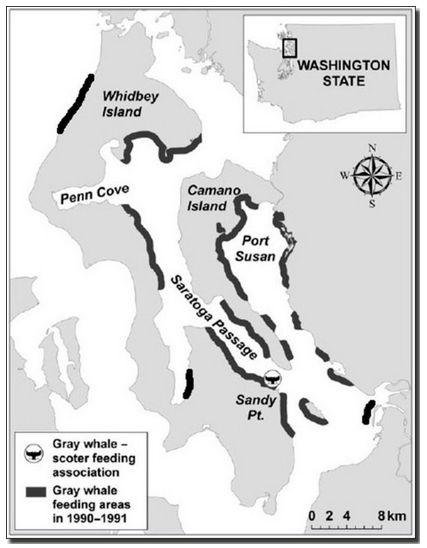Gray Whales
Gray Whales Eschrichtius robustus
Orca Network’s comprehensive 28-page
Guide to Gray Whales
Changes in gray whale phenology and distribution related to prey variability and ocean biophysics in the northern Bering and eastern Chukchi seas.
Sue E. Moore, Janet T. Clarke, Stephen R. Okkonen, Jacqueline M. Grebmeier, Catherine L. Berchok, Kathleen M. Stafford
The Sounders (North Puget Sound gray whales) produced by Cascadia Research Collective.
Here are some facts and resources to help you get to know Gray whales better. You can also visit "Rosie" the Gray whale skeleton at the Coupeville Wharf (complete with baleen), or the Gray whale skeletons at the Whale Museum in Friday Harbor, the Poulsbo Marine Science Center, or the Port Townsend Marine Science Center.
Gray whales make pits in sandy sediments to suction up shrimp all along Saratoga Passage, Port Susan, and parts of Possession Sound.
Gray whale feeding pits at low tide in Saratoga Passage and Port Susan.
The Gray whale gets its name from its mottled gray skin, which is covered with barnacles and whale lice. They are 15' - 16' at birth, live to be 50 years or more, and grow to a length of 40' - 45' and a weight of approx. 30 tons, reaching sexual maturity at five to eleven years of age.
The Gray whale’s two blowholes create a spout that resembles a heart shape.
Photo by Andrew Lees
Gray whales are appreciated for their friendly approaches to people in small boats in their mating and calving grounds in Mexico, where they are often seen spy-hopping, lobtailing and breaching.
There are 200-300 "seasonal resident" Gray whales that spend the spring, summer, and fall feeding from California to SE Alaska, known as the Pacific Coast Feeding Group (PCFG).



